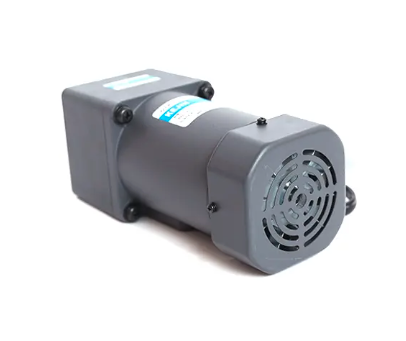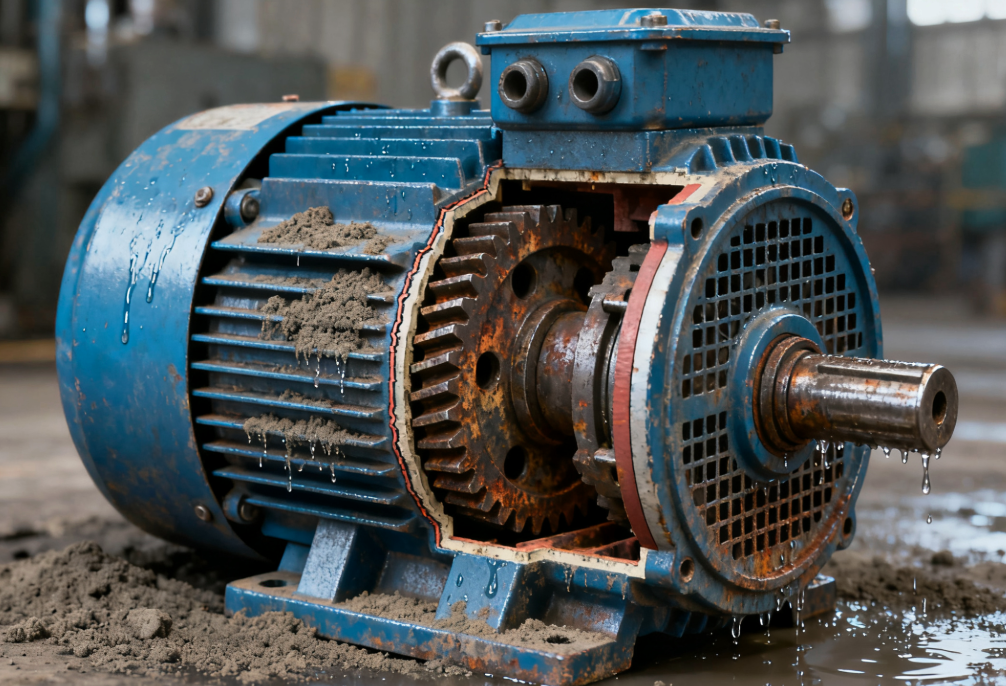- All
- Product Name
- Product Keyword
- Product Model
- Product Summary
- Product Description
- Multi Field Search


Views: 0 Author: Site Editor Publish Time: 2025-10-04 Origin: Site










Selecting the right gearmotor is crucial for efficient machinery and long-term reliability. The right choice impacts energy consumption, machine performance, and operational costs. Whether you are upgrading equipment or designing a new system, understanding torque, speed, duty cycle, environment, and electrical requirements ensures optimal performance. In this guide, we’ll explore five key factors to consider when sizing and selecting a gearmotor, helping you make informed decisions for your application.
Understanding load requirements is the foundation for selecting the right gearmotor. The load defines the torque and speed needed to drive your application effectively. Heavy machinery, like conveyors or lifting equipment, requires high torque, while smaller devices, such as robotic arms or packaging machines, need precise, controlled motion.
Key Points to Consider:
Weight, shape, and friction of the load
Starting and stopping forces
Shock, intermittent loads, or sudden acceleration
Torque Calculation Tips:
Measure load mass and radius of rotation accurately.
Estimate friction and mechanical losses from bearings or couplings.
Apply torque formula: $Torque = Force × Distance$.
Example Table: Load Type vs Torque Requirement
| Load Type | Torque Needed (Nm) | Motor Recommendation |
|---|---|---|
| Light duty | 5–15 | Small DC or AC gearmotor |
| Medium duty | 20–50 | Standard AC/DC gearmotor |
| Heavy duty | 60+ | High-torque industrial motor |
Extra Tip: Consider peak torque requirements for start/stop cycles to avoid undersizing the motor, which can cause premature gear or bearing failure.

The output speed of a gearmotor must match the needs of the application. Using a motor at too high or too low speed can reduce efficiency, increase wear, or even damage the machinery. Proper speed selection is crucial for optimal performance and longevity of the gearmotor.
Factors to Check:
Maximum and minimum speed needed: Determine the range of speeds required for the application. This helps in selecting a gearmotor that can operate efficiently within these limits.
Load inertia and acceleration/deceleration requirements: Consider the inertia of the load and the required acceleration and deceleration rates. High inertia loads may need more torque to start and stop, affecting the speed selection.
Precision needed for motion control: Especially in robotics or CNC machines, precision is critical. The gearmotor must be able to maintain consistent speed and positioning accuracy to ensure high-quality output.
Tip: Using variable-speed gearmotors can help adapt to multiple operational modes, increasing versatility and reducing energy waste. These gearmotors can adjust their speed based on the application’s needs, providing flexibility and efficiency.
Visual Idea: A line chart showing recommended motor speeds across different applications: packaging, conveyors, robotics, and industrial mixers. This chart can help users quickly identify the appropriate speed range for their specific application.
Maintenance and Monitoring:
Regular Inspection: Regularly inspect the gearmotor for signs of wear or damage. This includes checking the gears, bearings, and motor windings.
Speed Monitoring: Implement speed monitoring systems to ensure the gearmotor is operating within the specified speed range. This can help identify issues early and prevent damage.
Lubrication: Ensure proper lubrication of the gearmotor to reduce friction and wear, especially when operating at high speeds.
The duty cycle defines how long a motor can safely run before it needs a rest. Motors operating at high duty cycles without proper thermal management can overheat, leading to shortened life.
Checklist:
Determine if usage is continuous, intermittent, or occasional
Check rest intervals and cooling needs
Verify the motor’s thermal rating and protection class
Example Table: Duty Cycle vs Cooling Recommendation
| Duty Cycle Type | Typical Runtime | Cooling Recommendation |
|---|---|---|
| Continuous | 24/7 | High-capacity cooling |
| Intermittent | 30 min/hour | Standard cooling |
| Occasional | <10 min/hour | Basic protection |
Extra Tip: Motors running intermittent duty may still require cooling if they experience frequent starts or heavy loads. Using thermal sensors can prevent overheating and unexpected shutdowns.
Gearmotors face different operational environments, which significantly affect performance and lifespan. Temperature extremes, humidity, dust, chemicals, and vibrations can damage internal components if not properly protected.
Questions to Ask:
Indoors or outdoors?
Exposure to dust, moisture, or corrosive chemicals?
Will there be vibration, shocks, or impacts?
Tip: Choose motors with appropriate IP ratings and protective housings. Motors exposed to harsh environments benefit from sealed bearings, corrosion-resistant coatings, or specialized lubricants.
Illustration Idea: Annotated diagram highlighting high-risk areas such as motor casing, shaft seal, and ventilation openings, showing common wear points under harsh conditions.
Additional Insight: Consider ambient temperature derating; motors may need oversized torque capacity in high-temperature conditions to maintain performance.

Electrical compatibility ensures safe and efficient motor operation. Voltage, current, frequency, and starting conditions are essential to avoid underperformance or electrical hazards.
Checklist:
Verify voltage matches your system (single-phase, three-phase, or DC)
Check running and starting current requirements
Ensure compatibility with motor controller or drive system
Example Table: Electrical Specs vs Motor Type
| Motor Type | Voltage (V) | Current (A) | Frequency (Hz) |
|---|---|---|---|
| Small DC Gearmotor | 12–48 | 0.5–5 | N/A |
| Standard AC Gearmotor | 110–480 | 2–50 | 50/60 |
| Industrial High Torque | 220–600 | 20–100 | 50/60 |
Extra Tip: Overvoltage or undervoltage can reduce motor lifespan. Using soft starters, VFDs, or current-limiting devices can optimize energy use and prevent damage.
Beyond the main five factors, other elements can significantly impact gearmotor reliability and performance. Addressing these additional considerations can enhance the overall efficiency and longevity of your gearmotor system.
In precision or quiet environments, such as laboratories, hospitals, or recording studios, excessive noise and vibration can be disruptive and detrimental. Gearmotors that produce minimal noise and vibration are essential in these settings. Consider the following:
Low-Noise Design: Opt for gearmotors with designs that inherently produce less noise. This can include using high-quality bearings, optimized gear designs, and advanced materials.
Vibration Dampening: Implement vibration dampening techniques, such as rubber mounts or isolation pads, to minimize the transmission of vibrations to the surrounding environment.
Sound Insulation: In some cases, additional sound insulation around the gearmotor can help reduce noise levels further.
The quality of materials used in the gearmotor can significantly impact its durability and resistance to harsh environments. Consider the following:
Corrosion Resistance: Use materials that are resistant to corrosion, such as stainless steel or specialized coatings, if the gearmotor will be exposed to corrosive substances or environments.
Dust and Debris Resistance: Select materials and designs that can withstand dusty or debris-filled environments. This might include sealed housings or protective covers.
High-Quality Components: Invest in high-quality gears, bearings, and motor components to ensure reliability and longevity. High-quality materials can withstand more wear and tear, reducing the likelihood of premature failure.
Measure the load, consider friction and inertia, then calculate torque using $Torque = Force × Distance$.
Yes, but ensure it has a high-duty cycle rating and proper cooling to prevent overheating.
Temperature, moisture, dust, chemicals, and vibration significantly impact motor life. Choose motors with appropriate protection ratings.
Precision applications require motors with accurate speed and feedback control; standard motors may not suffice.
Choosing the right gearmotor means considering load, speed, duty cycle, environment, and electrical requirements. Proper selection prevents downtime, improves efficiency, and reduces maintenance costs. For high-quality gearmotors and expert guidance,Qingdao Chinese Science Machinery Co., Ltd. stands out as a trusted partner. Our company offers reliable products, extended warranty coverage, and professional support to ensure your operations run smoothly. By choosing Qingdao Chinese Science Machinery Co., Ltd., you’re investing in durability, precision, and innovation. Acting on these considerations now with our expert assistance avoids costly repairs and maximizes machine lifespan.